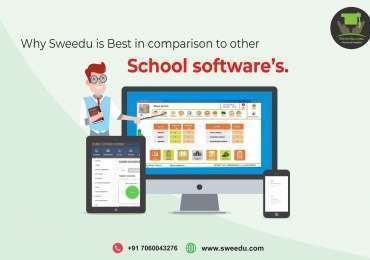Introduction
The world of education has undergone a tremendous transformation over the years. From chalkboards to whiteboards, and now, to smart boards, the way we teach and learn has evolved significantly. But what exactly are smart boards, and how do they enhance the learning experience? Let’s dive into this fascinating topic and explore how Sweedu Digital Education is revolutionizing classroom learning with smart boards.
What are Smart Boards?
Definition and Features
Smartboards are interactive whiteboards that combine traditional whiteboards’ functionality with a computer’s power. They allow teachers and students to interact with digital content using touch or specialized pens. Features often include multi-touch capabilities, internet connectivity, and integrating multimedia content.
Types of Smart Boards
There are several types of smart boards available, each catering to different needs and budgets. These include resistive touch screens, infrared touch screens, and capacitive touch screens, each offering varying levels of sensitivity and durability.
Benefits of Smart Boards in Education
Enhanced Student Engagement
Smart boards make lessons more engaging by incorporating visuals, sounds, and interactive activities. This multimedia approach captures students’ attention and keeps them interested in the material.
teractive Learning Experience
Students can participate actively in lessons by solving problems on the board, playing educational games, or interacting with simulations. This hands-on approach makes learning more dynamic and enjoyable.
Accessibility for All Students
Smart boards can cater to diverse learning needs. Features like text-to-speech, magnification, and translation services ensure that all students, including those with disabilities, can benefit from the lessons.
How Sweedu Digital Education Integrates Smart Boards
Implementation Process
Sweedu’s implementation process is straightforward and tailored to each school’s needs. They provide comprehensive training for teachers and ongoing technical support to ensure smooth integration.
Customizable Features
Sweedu’s smart boards come with customizable features that can be adapted to different teaching styles and curriculum requirements. This flexibility allows teachers to create personalized learning experiences for their students.
Boosting Student Engagement with Smart Boards
Real-time Collaboration
Smart boards enable real-time collaboration among students. They can work together on projects, share ideas instantly, and get immediate feedback from their teachers.
Multimedia Integration
Teachers can incorporate videos, animations, and audio clips into their lessons, making abstract concepts easier to understand. This multimedia integration helps to cater to various learning styles.
Interactive Learning through Smart Boards
Hands-on Activities
Smart boards support a variety of hands-on activities, such as drawing, writing, and manipulating objects on the screen. These activities make learning more interactive and enjoyable.
Gamified Learning
By incorporating educational games into lessons, smart boards make learning fun and competitive. This gamified approach motivates students to participate actively and strive for excellence.
Smart Boards and Teacher Support
Professional Development
Sweedu provides professional development programs to help teachers become proficient in using smart boards. These programs cover everything from basic operations to advanced teaching strategies.
Ease of Lesson Planning
With smart boards, teachers can save and organize their lessons digitally. This ease of lesson planning saves time and allows for more efficient teaching.
Accessibility and Inclusivity
Supporting Diverse Learning Needs
Smart boards are equipped with features that support diverse learning needs, such as adjustable text sizes, high-contrast modes, and screen readers.
Language and Translation Features
For classrooms with multilingual students, smart boards offer translation services that help bridge language barriers. This inclusivity ensures that all students can participate fully in the lessons.
Challenges and Solutions
Common Obstacles
Despite their many benefits, smart boards can present challenges such as technical issues, high costs, and the need for ongoing teacher training.
Strategies for Effective Use
To overcome these obstacles, schools can invest in reliable technical support, seek funding opportunities, and provide continuous professional development for teachers.
Future of Smart Boards in Education
Technological Advancements
The future of smart boards looks promising with advancements like augmented reality (AR) and virtual reality (VR) integration. These technologies will further enhance the interactive learning experience.
Predictions for Classroom Learning
As technology continues to evolve, smart boards will become even more integral to classroom learning. They will play a crucial role in creating dynamic and inclusive educational environments.
Conclusion
Smart boards are transforming the way we teach and learn, making education more engaging, interactive, and inclusive. Sweedu School erp software with Digital Education is at the forefront of this transformation, providing innovative solutions that enhance learning experiences for all students. By integrating smart boards into classrooms, we can create a brighter and more dynamic future for education
FAQs
What are the main benefits of using smart boards in classrooms?
Smart boards enhance student engagement, provide interactive learning experiences, and support accessibility for all students.
How do smart boards support different learning styles?
Smart boards cater to various learning styles by incorporating multimedia elements such as visuals, sounds, and interactive activities.
Can smart boards be used for remote learning?
Yes, smart boards can be used for remote learning, allowing teachers to deliver interactive lessons online and students to participate from home.
What training is needed for teachers to use smart boards effectively?
Teachers need professional development programs that cover basic operations, advanced features, and effective teaching strategies for using smart boards.
How do smart boards contribute to inclusive education?
Smart boards offer accessibility features such as text-to-speech, magnification, and translation services, ensuring that all students can participate fully in lessons.






